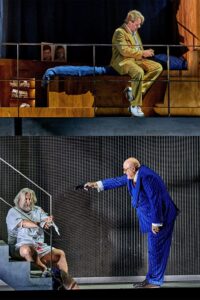Well, I have been taught once again to never say never. I didn’t make it to the premiere of Valentin Schwarz’s production of Der Ring des Nibelungen, as I still had other some Bayreuth stagings from previous years to catch up on. Last year I gave the new tetralogy a miss as well – discouraged by the generally scathing reviews of the director’s vision, the uneven, in a few cases even ill-judged cast and the return to the podium of the young, undoubtedly talented, but not very experienced Finnish conductor Pietari Inkinen, who in 2021 deprived me of any vestiges of pleasure in experiencing my beloved Die Walküre. This season I ran out of arguments – after Cornelius Meister and then after Inkinen, the baton was taken over by Simone Young, to whose debut on the Green Hill we had been looking forward for years. The other sensational announcement was that Michael Spyres would sing Siegmund, an announcement all the more sensational given that this was a double debut – the American tenor had never sung the role on stage before. Professional curiosity prevailed, although I must confess remorsefully that I got myself accredited only for Das Rheingold and Die Walküre. After what I saw and heard, I do not rule out that next year I might take one last opportunity to get to know the whole thing – if only to verify some of the interpretive tropes I spotted when analysing the first two parts of the Ring.
Schwarz arrived in Bayreuth with a hard-earned reputation of an iconoclast and a rebel. He announced that he intended to direct the Ring as if it were a four-part saga on Netflix – a story about the problems and dilemmas of a modern family, adapted to the sensibilities of today’s audiences, with all the resulting dramatic consequences of this decision. Fully aware that Wagner had drawn on dozens of sources to create his own mythology, Schwarz felt himself a myth-maker as well and, as he put it, “with consistent disrespect” for the libretto, made fundamental changes in it: not in the textual but in the interpretive layer. He made the conflict between the two twin brothers, Alberich and Wotan, the dramatic axis of the whole. He replaced the Rhine gold physically present in the Ring with a multiple symbol of power. He turned Sieglinde – pregnant even before the arrival of Siegmund – into a victim of Wotan’s rape, completely turning the relationship between the protagonists of Die Walküre upside down. As Schwarz resorted to comparisons with cinematic attempts to demythologise established myths, let me point out that in Netflix’s nearly thirty-year history no one has made an adaptation so far removed from the original that the viewer – in order to understand anything about it – has to use the director’s extensive commentary. Such commentary was not necessary even in the case of the mad Norwegian series Ragnarok, whose creators took a merciless approach not only to Norse mythology, but also to Der Ring des Nibelungen – and yet the narrative remained clear, above all for the production’s main target audience, that is pimply teenagers who didn’t always have a clue why a certain nursing home resident in the fictional town of Edda wore a black eye patch and was called Wotan Wagner.
Das Rheingold. Tomasz Konieczny (Wotan), Ólafur Sigurdarson (Alberich), and John Daszak (Loge). Photo: Enrico Nawrath
Thus, from a conceptual point of view Schwarz’s Ring is a complete disaster, but visually a perversely attractive disaster, mainly due to Andrea Cozzi’s excellent set design, Andy Besuch’s fine costumes, Nicola Hungsberg’s efficient lighting direction, prepared this year on the basis of Reinhard Traub’s original concept, and – last but not least – the extraordinary qualities of the Festspielhaus stage, the depth of which enhances every detail and brightens every colour. However, Schwarz doesn’t know how to use this brilliantly arranged space, which evokes only superficial associations with a movie set. The narrative unfolds in too many places at once, becomes distracting owing to the impossibility of using close-ups and long camera zoom-ins and, as a result, gets bogged down in the tangled, disjointed side plots.
And yet it is possible to discern in all this a desperate attempt to lure the audience with the promise of a mystery. There is no gold, no ring, no Nothung in this staging, but there are symbols that are yet to be fully explained – perhaps their meaning will be unveiled in the subsequent parts of the cycle. Could it be that gold is the ghastly, cruel boy in a yellow shirt, whom Alberich kidnaps from the custody of the Rhinemaidens? Or perhaps it’s just an illusion, perhaps the real metaphor for the primordial order of nature is the two children in Die Walküre sprinkled with golden glitter – embodied visions of the original state of innocence of Sieglinde and Siegmund? What does the pyramid, shown in various forms, mean? Could it be that in all its manifestations – from a polyhedral variation of Rubik’s cube that Wotan gives the infernal boy to play with, to the luminous space that Brünnhilde heads for in the finale of Die Walküre – it is an ambiguous symbol of power and violence, the ring, Tarnhelm and Wotan’s spear in one?
We don’t get an answer to these questions and I doubt – I may be wrong, though – that we will get it at the end of the Ring. Schwarz has some decent directorial skills, and from time to time he enlivens this incoherent tale of a toxic family with finely played episodes and charming acting scenes that, instead of developing into a coherent narrative, burst like soap bubbles. Like the brilliant, if a bit over-the-top, scene in which Erda impetuously hurls a tray full of champagne glasses against the floor before “Weiche, Wotan, weiche”. Like the beginning of Act I of Die Walküre, in which Hunding, amidst the flashes of a thunderstorm, struggles with a panel of blown electrical fuses. Like the well-captured essence of Siegmund’s disappointment, when, hearing that he will not be reunited with Sieglinde in Valhalla, he abandons his suitcase packed for the journey to the palace of the fallen. Yet most of Schwarz’s ideas come from nowhere and lead nowhere, and this includes the spectacular Non-Ride of the Valkyries: shrouded in bandages and recuperating in a plastic surgery clinic.
Das Rheingold. Tobias Kehrer (Fafner), Jens-Erik Aasbø (Fasolt), Nicholas Brownlee (Donner), Christina Nilsson (Freia), and Mirko Roschkowski (Froh). Photo: Enrico Nawrath
I wonder to what extent this pandemonium of post-dramatic theatre influenced casting choices and style of performance of the various vocal parts. In Das Rheingold, in line with Schwarz’s concept, we got the twins Alberich and Wotan in the form of two repulsive shady-looking characters, whose singing – far from any canons of beauty and subtlety – carried only a powerful charge of contempt, frustration and hatred (Ólafur Sigurdarson and Tomasz Konieczny, respectively). An emotionless and prematurely aged Fricka found a convincing performer in Christa Mayer, who possesses an already tired mezzo-soprano with an excessive vibrato. Freia, terrified and almost in catatonia, was heard in Christina Nilsson’s lovely but at times seemingly frozen voice. Ya-Chung Huang’s technically assured tenor had to cope with an extremely one-dimensional, even caricatural vision of Mime. The same applies to John Daszak, whose interpretation of Loge came as if straight from English vaudeville – which is not surprising, given that Schwarz imagined him as Wotan’s family lawyer. Okka von der Damerau as Erda successfully made up for her technical shortcomings with her expressiveness. Of the two giant brothers the one I found more memorable was Fafner, sung by Tobias Kehrer with a fairly small and at times unstable, but very charming bass. Mirko Roschkowski (Froh) paled in comparison with the excellent Nicholas Brownlee as Donner (I looked up the cast of Das Rheingold to be presented at the Bayerische Staatsoper in the autumn and discovered with satisfaction that I wasn’t the only person to hear more of a Wotan in him). I found softness and lyricism only in the singing of the Rhinemaidens – this makes me all the happier to note a fine performance by the Polish mezzo-soprano Natalia Skrycka as Wellgunde. In the second instalment of the Ring characters familiar from the prologue were joined by Wotan’s traditionally screaming daughters, in comparison with whom Catherine Foster did surprisingly well in the role of Brünnhilde, sung musically, with great commitment and at times an indispensable sense of humour, although the English singer, who has an undoubtedly handsome soprano, as usual did not avoid problems with intonation and excessive vibrato.
Die Walküre. Michael Spyres (Siegmund) and Vida Miknevičiūtė (Sieglinde). Photo: Enrico Nawrath
Only the first act of Die Walküre fulfilled my dream of the truth of the most humane of Wagner’s musical dramas – thanks to two phenomenal Bayreuth debutants: Vida Miknevičiūtė, who conveyed all the anxiety, ecstasy and anguish of Sieglinde with a soprano that was quite sharp, but at the same time agile, spontaneous, sparkling with colour, impeccable in terms of both intonation and articulation; and Michael Spyres, who took Bayreuth by storm and immediately presented himself as one of the best Siegmunds in the festival’s post-war history. I admire the extraordinary intelligence of this singer, who perfectly senses the moment when a change of repertoire should be made without damaging the voice and, at the same time, in full harmony with the aesthetics and performance tradition of the newly mastered roles. His German still leaves a bit to be desired (this also applies to the production of certain vowels, which continue to bring to mind associations with the French grand opera), but in terms of vividness of his voice, his uniquely baritonal sound, beautifully open top and rounded notes at the bottom of the range, and above all the sensitive, truly song-like phrasing – I think Spyres would have delighted Wagner himself. The singing of this Sieglinde and this Siegmund could move a rock: it certainly moved the ever-dependable Georg Zeppenfeld, who complemented the artistry of the two singers with an astonishingly sensitive portrayal of the unloved, frustrated Hunding.
Die Walküre. Tomasz Konieczny (Wotan). Photo: Enrico Nawrath
It was worth coming to Bayreuth for this one act, for this hour of wonderful music making under Simone Young’s tender baton. The Australian conductor tried to brighten the score of the whole Ring, to extract hitherto neglected details from its texture, to emphasise the tragedy of gods, people and in-between beings with an almost impressionistic play of lights and shadows. She fully achieved this goal in the orchestral layer. When it came to singing, she often had to fight against recalcitrant matter, especially in Das Rheingold, when the soloists sometimes managed to drown out, shout down and stomp down the subtly and wisely playing orchestra. How much of this was Schwarz’s fault, how much was contributed by the booming singing manner, so beloved on the Green Hill, how much was contributed by the conductor herself, defending her vision against all odds – I might find out next year. I already know that the festival should let go of neither Miknevičiūtė, Young nor Spyres. Wagner’s masterpieces deserve the return of sensitive interpreters.
Translated by: Anna Kijak




